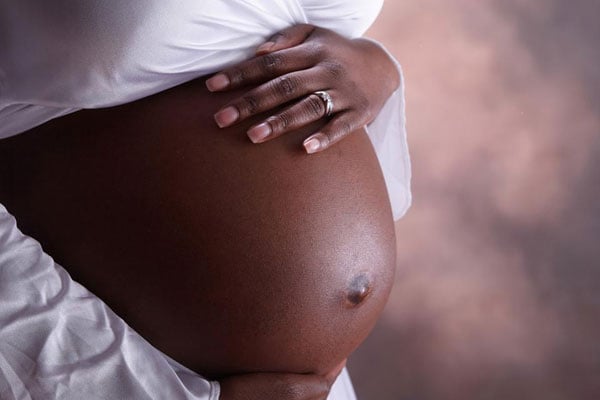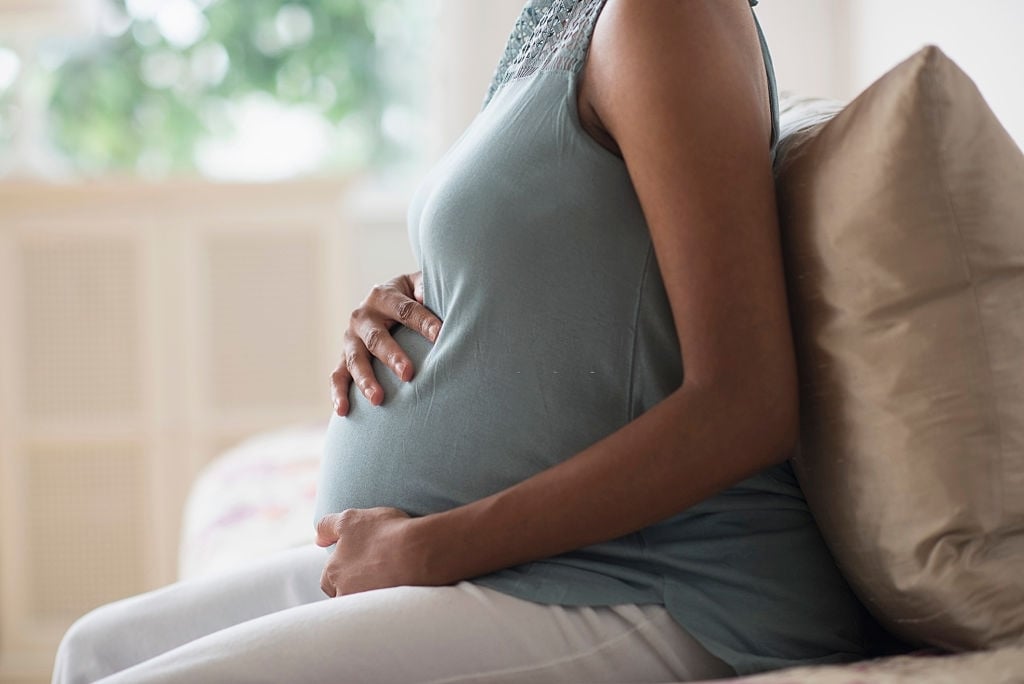Prime
How Uganda halved death of pregnant women in 7 years

A pregnant woman. PHOTO/COURTESY
What you need to know:
- Amid challenges such as human, infrastructure and financial constraints, the country has recorded a decline in maternal and child deaths between 2016 and 2022.
- Experts, however, say more needs to be done to ensure no mother or newborn dies.
The number of mothers dying in Uganda due to complications from pregnancy or childbirth has reduced by close to half in the last seven years.
The 2022 Uganda Demographic and Health Survey (UDHS) report, released last week in Kampala, reveals a general decline in maternal and infant deaths, pointing to an improvement in the quality of care and health-seeking behaviour.
Maternal mortality per 100,000 live births, according to UDHS reports, first reduced slightly from a high of 438 in 2011 to 336 in 2016, a decline of around 23 percent.
However, in the 2022 UDHS report, there was a major decline of around 44 percent to 189 deaths of mothers per 100,000 live births.
Dr Jesca Nsungwa, the commissioner for maternal and child health at the Health ministry, said the decline shows that the country’s interventions are working.
“There has been a deliberate effort to make sure that women and children are able to access services, for example for delivery, which is appropriate. We have tried to improve the standard of care,” she said last week.
Dr Nsungwa said they have been able to achieve this through proper construction, equipping, and upgrading lower health facilities where the majority of the population seek care.
According to the 2020/2021 health sector performance report, 75 percent of 1.2 million deliveries happened in health centre IIs, IIIs, and IVs, while the rest were delivered in general and referral hospitals.
In the 2022 UDHS report, there was a marked increase in the number of women delivering in health facilities and those going for antenatal care, signalling an increase in health-seeking behaviour in the population. Subsequently, delivery in health facilities increased from 74 percent in 2016 to 91 percent in 2022.
“But there is that nine percent that is still using traditional birth attendants. Even those 91 percent that produces in health facilities, not all of them finish recommended antenatal visits. These are the areas that the Ministry of Health and other stakeholders must address,” said Dr Chris Mukiza, the Uganda Bureau of Statistics (UBOS) executive director. UBOS conducted the 2022 UDHS.
In the report, there was also a marked variation in deaths of babies and other health indicators across the regions of the country.
Dr Mukiza said: “Regions with high poverty indicators also have dismal health and demographic indicators. When people’s health status is not good, they cannot engage in productive activities.”
“That is why we ask the government to take these issues seriously. One of the important landmarks is maternal mortality rate which has dropped from 336 to 189 in 100,000 live births. We need to reduce this because we don’t want to see mothers dying while giving birth,” he added.
Drivers
Infant mortality (deaths before completing one year of life) per 1000 live births, also reduced from 43 in 2016 to 36 in 2022.
However, in the report, variation of figures across the regions was notable. Teso and Karamoja had the least cases of deaths, while West Nile and Ankole had the highest number of deaths. These disparities are pronounced, from 21 deaths per 1,000 live births in Teso to 55 per 1,000 live births in West Nile.
Dr Fredrick Edward Makumbi, a senior lecturer at Makerere University School of Public Health, said there is an urgent need for deeper analysis of data to find hidden drivers of deaths and the variations.
“We have a lot of data that we need to sit down to analyse, dissect and be able to identify where the gaps are and we go ahead and address them. There are variations in most of the indicators,” Dr Makumbi said.
He added: "There are opportunities we need to tap into. We need to use interventions such as family planning, increase involvement of community health workers and promote self-care. Our resources to run facilities are not unlimited, so, we need to empower women, men and children to care for themselves within the available resources and understanding.”
Dr Makumbi also said there is a need to address the issue of equity, even within urban areas for everybody to benefit from health services. “And we cannot risk having a one-size-fits-all approach. Through this, we can be able to make efforts and cause change in the indicators,” he added.

A mother lying on a bare floor at Kayunga pediatric ward in Uganda. PHOTO/HANDOUT/IRIN
However, the figures in the UDHS 2022 report are still very high if compared to countries like the United Kingdom where 10 women die out of 100,000 live births. As for infant mortality, in Europe, there are around four deaths per 1,000 live births, according to available statistics.
Dr Nsungwa on the other hand said: “The low-hanging fruits are almost gone and that is why we need to tackle things like newborn health. We need to have more advanced care. As we advance care, we need to make sure that quality of care is improved.”
“We need to invest more to improve the satisfaction of our clients and that means we need to focus on the human resource –the type of people we have there. We need more funding and look at where performance is still low and improve,” she added.
In the 2022 UDHS report, the under-five mortality per 1,000 live births, declined from 64 in 2016 to 52. The deaths of babies within 28 days of life (neonatal), was at 22 per 1,000 live births, a decline from 27 per 1,000 live births in 2016.
Health minister speaks out
Talking about the report last week, Dr Jane Ruth Aceng, the health minister, said the decline in figures shows that the country can achieve more with the active involvement of the population and development partners.
“Having these statistics as they are after all those challenges amid limited resources, I must congratulate all Ugandans and our [development] partners. The UDHS 2022, was designed as a follow-up for previous surveys and the latest having been conducted in 2016,” she said.
The minister also said the report’s findings come at a time when they are undertaking various health programmes and reforms to ensure that citizens have equal access to health services as and when the need arises.
“The shift in various indicators as presented, is a result of successful health programmes that have been implemented over time with support from development partners. I have seen infant mortality has dropped from 43 to 36 deaths per 1,000 live births in the past five years (between 2016 and 2022),” she said.
Dr Aceng added: “Under-five mortality has also dropped from 64 to 52 deaths per 1,000 live births. These may look small but they [health workers] did a lot of work for us to reach where we are. When you look at the regions, the statistics are not so good, and we need to find the reason behind it.”
She said although there is a general decline, deaths are still unacceptable high due to many reasons. “One of them is, that the funding to the health sector has not increased. The health workforce is still a big problem, health education and promotion need to be intensified for our population to know why they need to work on this and a lot more,” she said.
Way forward
Dr Aceng added: "Maternal mortality reduced from 336 to 189 per 100,000 who give birth. This is not remarkable but it is good for us because efforts have been put in and the government is making a lot of investment along with development partners. Whereas we are still losing mothers during childbirth and labour, we can say a big congratulations because we have come from far, from nearly 501 to 189 deaths per 100,000 live births.”
The minister also said they need to strengthen some of the areas such as nutrition and also address variations among regions.
“We need to come together as a country and talk about the high fertility rate because producing 1.6 million children a year is a big burden on the economy in terms of having to look after them and their health. However, if Ugandans are committed to working hard and improving this economy, that would be okay,” she said.

The Minister for Health, Dr Jane Ruth Aceng presents during plenary session on June 22, 2023. PHOTO/ PARLIAMENT
Dr Aceng said they are expediting plans for national health insurance to allow for universal access to health care. “The health sector needs more resources to carry out more activities and activities related to prevention of diseases are not cheap [to undertake]. That is why I am calling for support to the national health insurance scheme,” she said.
“In this scheme, we are looking at mandatory enrolment for all Ugandans but also, we must be clear to all Ugandans that everybody will subscribe and contribute to the scheme and we have since seen that people don’t really appreciate what they don’t pay for,” Dr Aceng added.
Ms Agnes Bukare, a mother and resident of Tororo
District, said:“There is limited information about the need to go for antenatal check-up and to deliver at health facility.”
Mothers react
“The government should sensitise people, especially those in rural areas. The health facilities are also distant. You find in a big sub-county, there is only one health centre and also at the public health centres, the health workers want bribes for them to work on you. Men should also accompany and encourage their wives to go to hospital,” she added.
Dr Olive Sentumbwe, a mother and the World Health Organisation (WHO) family health and population advisor, said there is a need to improve the quality of care.
“We know that one in 10 patients are harmed while receiving care in our hospitals. Our care has issues, which should be addressed. 40 percent of our facilities lack running water and 30 percent lack sanitation facilities and this also affects the interest of our mothers in going to the facilities. Women also experience abuses at health facilities,” Dr Sentumbwe said.
Ms Evelyn Kajumba, a mother of one and a Kampala resident, agreed with Dr Sentumbwa, saying:
“The nurses and midwives should be taught on how to handle pregnant mothers and to put life first”.
“Some midwives can watch you bleed to death and are only quick to help those who have paid them some money,”Ms Kajumba added.
Ms Rebecca Akello, mother of two from Lira, said:
“The nurses and midwives in lower facilities delay women who are having complications in labour and delivery and some of them don’t pay attention. It is also hard to get an ambulance when a mother who is having labour complications has been referred to higher facility.”




